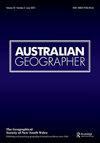Impact of Australian Bureau of Statistics data perturbation techniques on the precision of Census population counts, and the propagation of this impact in a geospatial analysis of high-risk foot hospital admissions among an Indigenous population
IF 2
2区 社会学
Q2 GEOGRAPHY
引用次数: 1
Abstract
ABSTRACT Precise population counts facilitate reliable estimation of differences in disease risk between population sub-groups or geographic regions, which informs rational public health decision-making. In Australia, Census population counts obtainable via the Australian Bureau of Statistics’ (ABS’) TableBuilder tool, which are widely used, are routinely perturbed to protect privacy. We examine this perturbation’s impact on: the precision of TableBuilder population counts, and a geospatial analysis of high-risk foot (HRF) hospital admissions among Western Australian (WA) Indigenous people. The former is severely compromised, disproportionately so for Indigenous people and under the currently employed ‘perturbation without additivity’ (PWoA) approach. E.g., based on fine-resolution, PWoA-affected data, the Indigenous population total for ‘Inner City’ WA was >50% lower than its true total. Imprecise calculation of WA Indigenous HRF admission counts, and misrepresentation of high-rate regions of such admissions in Perth, resulted. An approach suggested to manage this - examination of coarse-resolution data - is inadequate, partly due the modifiable areal unit problem. However, a novel map overlay technique alleviates this issue. We recommend that the ABS review the PWoA approach and consider implementing different statistical disclosure control techniques or reverting to the previously employed ‘perturbation with additivity’ approach, prior to releasing data from the 2021 Australian Census.澳大利亚统计局数据扰动技术对人口普查计数精度的影响,以及这种影响在土著人口高风险足部住院的地理空间分析中的传播
精确的人口计数有助于可靠地估计人群亚群或地理区域之间的疾病风险差异,从而为合理的公共卫生决策提供信息。在澳大利亚,通过澳大利亚统计局(ABS) TableBuilder工具获得的人口普查数据被广泛使用,但为了保护隐私,通常会受到干扰。我们研究了这种扰动对以下方面的影响:TableBuilder人口计数的精度,以及西澳大利亚(WA)土著人高风险足部(HRF)住院的地理空间分析。前者在目前采用的“无加性扰动”(PWoA)方法下受到严重损害,对土著人民来说尤其如此。例如,根据精细分辨率、受pwoa影响的数据,西澳州“内城”的土著人口总数比真实总数低50%。结果导致了对西澳土著HRF录取人数的不精确计算,以及对珀斯此类录取的高比率地区的歪曲。处理这种问题的方法——检查粗分辨率数据——是不充分的,部分原因是可修改的面积单位问题。然而,一种新的地图覆盖技术缓解了这个问题。我们建议ABS在发布2021年澳大利亚人口普查数据之前,审查PWoA方法,并考虑实施不同的统计披露控制技术,或恢复到以前使用的“扰动加性”方法。
本文章由计算机程序翻译,如有差异,请以英文原文为准。
求助全文
约1分钟内获得全文
求助全文
来源期刊

Australian Geographer
GEOGRAPHY-
CiteScore
4.10
自引率
8.30%
发文量
33
期刊介绍:
Australian Geographer was founded in 1928 and is the nation"s oldest geographical journal. It is a high standard, refereed general geography journal covering all aspects of the discipline, both human and physical. While papers concerning any aspect of geography are considered for publication, the journal focuses primarily on two areas of research: •Australia and its world region, including developments, issues and policies in Australia, the western Pacific, the Indian Ocean, Asia and Antarctica. •Environmental studies, particularly the biophysical environment and human interaction with it.
 求助内容:
求助内容: 应助结果提醒方式:
应助结果提醒方式:


